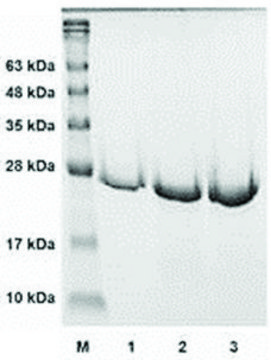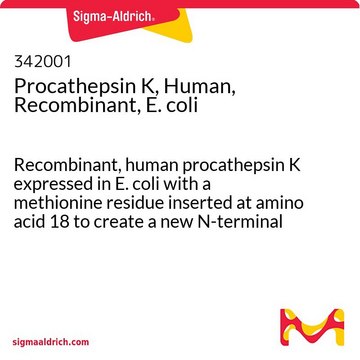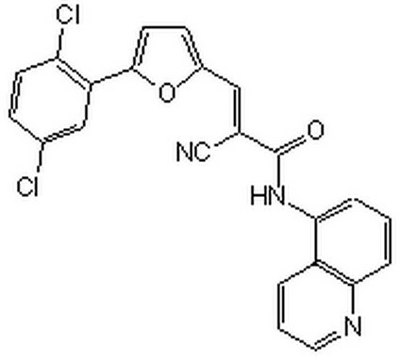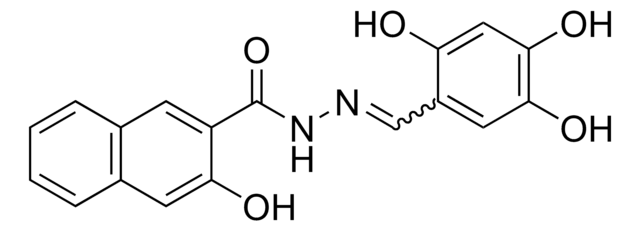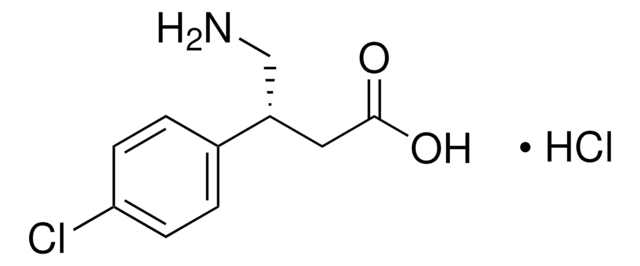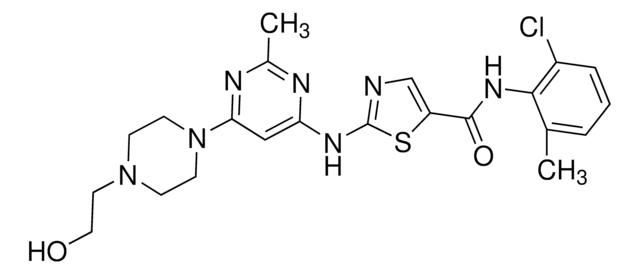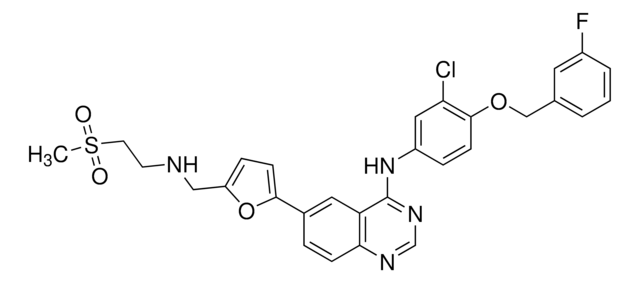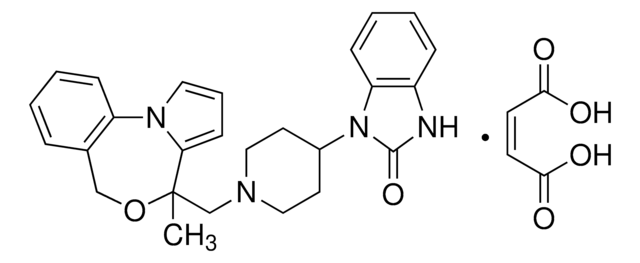推荐产品
生物来源
human
重组
expressed in E. coli
方案
≥95% (SDS-PAGE)
表单
liquid
包装
pkg of 10 μg
浓度
~200 μg/mL
杂质
Endotoxin, tested
NCBI登记号
运输
dry ice
储存温度
−70°C
基因信息
human ... CATK(1513)
一般描述
Procathepsin K is the inactive proenzyme of cathepsin K. Cathepsin K is a lysosomal cysteine protease and part of the papain cysteine protease family. It is expressed in osteoclasts. The gene encoding this protein is localized on human chromosome 1q21.
生化/生理作用
Cathepsin K has a role in bone resorption and remodeling. It has a triple helical collagen hydrolase activity. Mutations in the gene encoding this protein have been linked to pycnodysostosis.
外形
Liquid (25 mM Tris pH 8.0, 500 mM NaCl)
其他说明
Procathepsin K can be activated by adjusting the pH 4.0 by adding an equal volume of 100 mM NaAc pH 3.9, 10 mM DTT, 5 mM EDTA followed by incubation for 40 min at RT. Activated mature Cathepsin is highly auto-proteolytic at pH 4.0, and care must be taken to avoid self-proteolysis. If the activated enzyme is not used immediately, we recommend to add methyl methanthiosulfonate (1 mM final concentration; MeS-SO2Me; MMTS) and to freeze the sample in liquid nitrogen or on dry ice. The hydrophobic thiol-reactive compound MMTS modifies cysteine′s by attaching its relatively small, uncharged thiomethyl-blocking group to reactive sulfhydryl groups (Nishimura et al., 1975). This reversible reaction arrests the auto-proteolytic process. The activity of the enzyme can be restored to nearly unmodified levels by adding L-cysteine (3M excess over MMTS) to the enzyme solution.
储存分类代码
12 - Non Combustible Liquids
WGK
WGK 3
闪点(°F)
Not applicable
闪点(°C)
Not applicable
法规信息
常规特殊物品
Vito Turk et al.
Biochimica et biophysica acta, 1824(1), 68-88 (2011-10-26)
It is more than 50 years since the lysosome was discovered. Since then its hydrolytic machinery, including proteases and other hydrolases, has been fairly well identified and characterized. Among these are the cysteine cathepsins, members of the family of papain-like
Xianglan Huang et al.
Calcified tissue international, 96(5), 373-378 (2015-03-03)
Pycnodysostosis is a rare autosomal recessive skeletal dysplasia characterized by short stature, osteosclerosis, acro-osteolysis, frequent fractures, and skull deformities. Mutation in the gene encoding cathepsin K (CTSK), which is a lysosomal cysteine protease, has been found to be responsible for
Jaime Toral-López et al.
Journal of investigative medicine : the official publication of the American Federation for Clinical Research, 59(2), 277-280 (2010-11-26)
Pycnodysostosis, an autosomal recessive skeletal dysplasia, is characterized by short stature, osteosclerosis, delayed cranial suture closure, hypoplastic mandible, acro-osteolysis, hypoplastic clavicle, and dental anomalies. The disorder is caused by CTSK gene defects, a gene localized on 1q21. To describe the
Guangxian Zhao et al.
PloS one, 10(8), e0136093-e0136093 (2015-08-25)
Cysteinyl cathepsin K (CatK) is one of the most potent mammalian collagenases involved in cardiovascular disease. Here, we investigated the clinical predictive value of serum CatK levels in patients with chronic heart failure (CHF). We examined 134 patients with CHF
Joaquín Bobillo Lobato et al.
Medicina clinica, 145(7), 281-287 (2015-02-11)
Gaucher disease is an inherited disorder caused by deficit of acid β-glucocerebrosidase, responsible for the degradation of glucosylceramide to ceramide and glucose. Although the disorder is primarily hematologic, bone is the second most commonly affected structure. Cathepsin K (CATK) is
我们的科学家团队拥有各种研究领域经验,包括生命科学、材料科学、化学合成、色谱、分析及许多其他领域.
联系技术服务部门